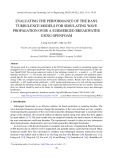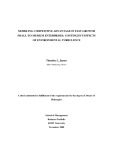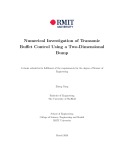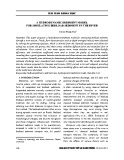
Turbulence Model
-
The present work is to evaluate the performance of the RANS turbulence models for simulating regular wave propagation over a submerged breakwater using the open-source Computational Fluid Dynamics (CFD) software OpenFOAM.
 15p
15p  vifaye
vifaye
 20-09-2024
20-09-2024
 6
6
 2
2
 Download
Download
-
This thesis develops a contingency-based model for competitive advantage, tested over time on a sample of rapidly growing small-to-medium enterprises. Incorporating two independent studies, the project addresses interactions between specific elements of strategic orientation, strategic behaviour, firm performance, while examining the moderating role of environmental turbulence.
 243p
243p  runthenight04
runthenight04
 02-02-2023
02-02-2023
 5
5
 2
2
 Download
Download
-
The current research is undertaken by performing Computational Fluid Dynamics (CFD) simulations for a 2D aerofoil fitted with a shock control bump at a transonic flow condition. Reynolds-Averaged Navier-Stokes equation coupled with turbulence models is adopted to solve the flowfield. The bump has a conventional geometric feature which consists of a ramp, a crest and a tail, and it has eight variants for which the designed parameters are reasonably specified according to the compressible aerodynamics theory.
 84p
84p  runthenight04
runthenight04
 02-02-2023
02-02-2023
 7
7
 3
3
 Download
Download
-
The goal of this study is to demonstrate and quantify the impact that the uncertainty in thermophysical properties has on key metrics of thermal hydraulic importance for MSRs, in particular on the heat transfer coefficient. In order to achieve this, computational fluid dynamics (CFD) simulations using the RANS k-ω SST model were compared to published experiment data on molten salt.
 13p
13p  christabelhuynh
christabelhuynh
 29-05-2020
29-05-2020
 19
19
 1
1
 Download
Download
-
Bài viết trình bày phương pháp số để nghiên cứu dòng chảy đằng sau một Turbine thủy triều, thông qua việc so sánh hiệu quả của một số Turbulence models như: k-ε Standard, k-ε Realizable, k-ω SST và Reynolds Stress Model (RSM) trong chương trình ANSYS FLUENT.
 9p
9p  vivinci2711
vivinci2711
 20-08-2019
20-08-2019
 44
44
 4
4
 Download
Download
-
This paper proposes a hydrodynamic/sediment model for simulating bedload sediment through a river section. Firstly, flow characteristics such as depth-averaged velocity were obtained by solving the governing equation, which is derived from the Reynolds equations and allows for taking into account the gravity, bed shear stress, turbulent diffusion force and secondary flow in calculations.
 8p
8p  thihuynh3006
thihuynh3006
 16-03-2018
16-03-2018
 49
49
 0
0
 Download
Download















